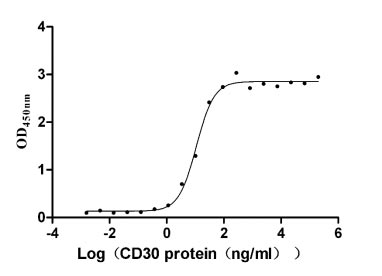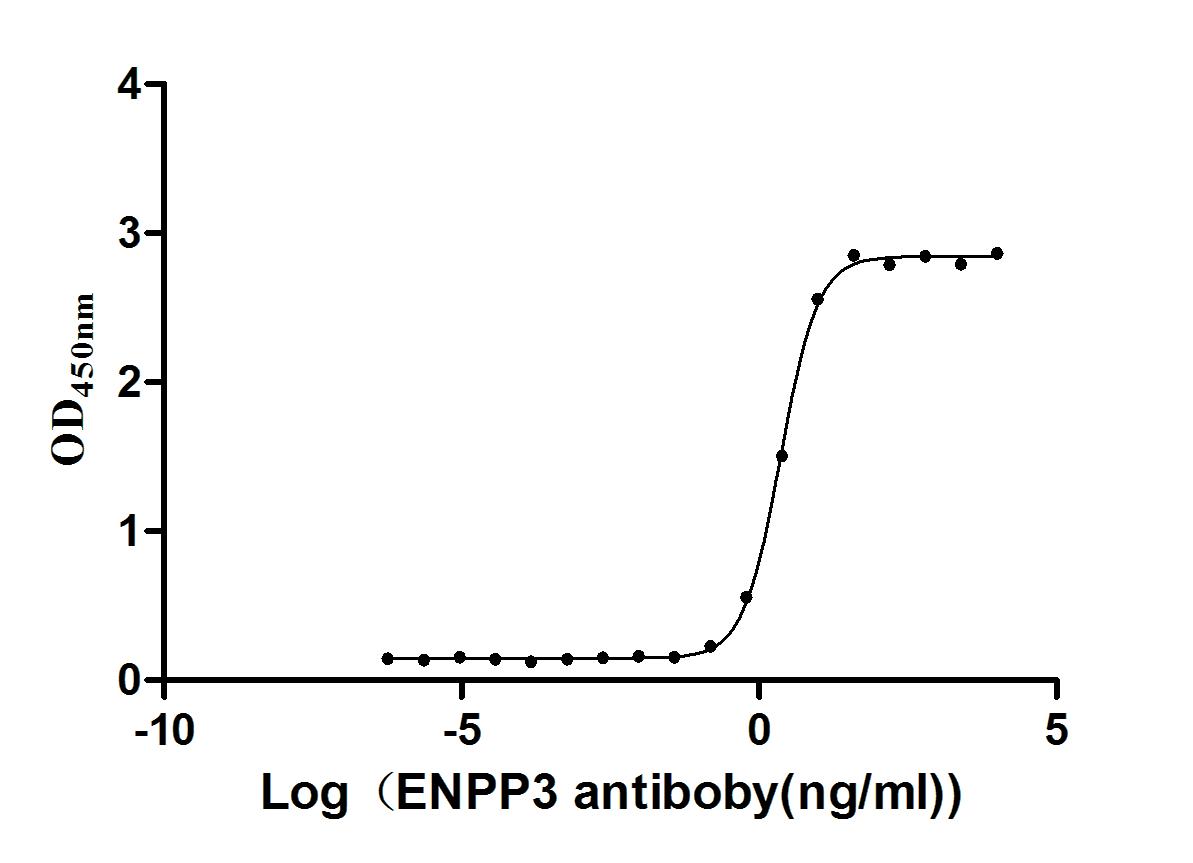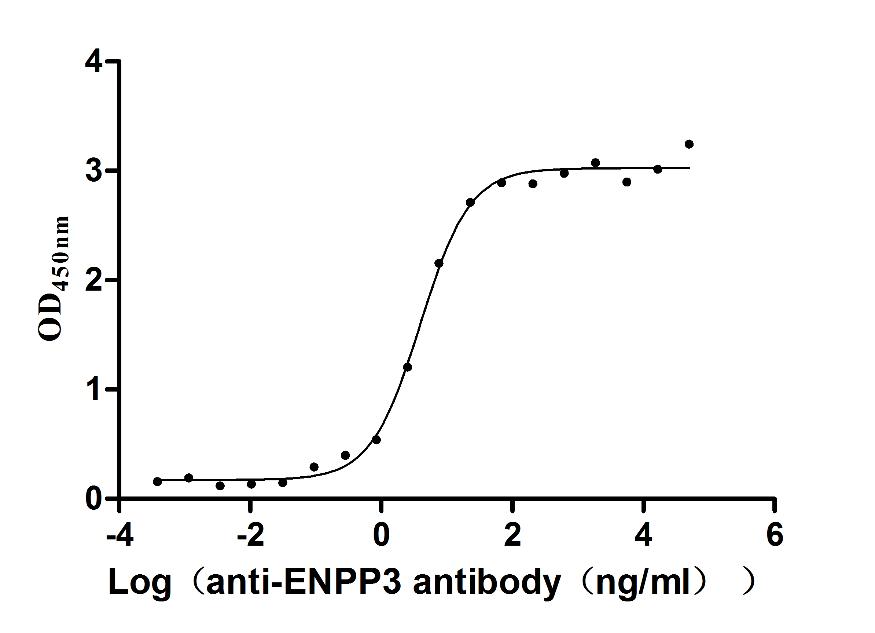Recombinant Human C-C chemokine receptor type 7 (CCR7), partial
-
货号:CSB-YP004846HU1
-
规格:
-
来源:Yeast
-
其他:
-
货号:CSB-EP004846HU1-B
-
规格:
-
来源:E.coli
-
共轭:Avi-tag Biotinylated
E. coli biotin ligase (BirA) is highly specific in covalently attaching biotin to the 15 amino acid AviTag peptide. This recombinant protein was biotinylated in vivo by AviTag-BirA technology, which method is BriA catalyzes amide linkage between the biotin and the specific lysine of the AviTag.
-
其他:
-
货号:CSB-BP004846HU1
-
规格:
-
来源:Baculovirus
-
其他:
-
货号:CSB-MP004846HU1
-
规格:
-
来源:Mammalian cell
-
其他:
产品详情
-
纯度:>85% (SDS-PAGE)
-
基因名:
-
Uniprot No.:
-
别名:CCR7; CMKBR7; EBI1; EVI1; C-C chemokine receptor type 7; C-C CKR-7; CC-CKR-7; CCR-7; BLR2; CDw197; Epstein-Barr virus-induced G-protein coupled receptor 1; EBV-induced G-protein coupled receptor 1; MIP-3 beta receptor; CD antigen CD197
-
种属:Homo sapiens (Human)
-
蛋白长度:Partial
-
蛋白标签:Tag type will be determined during the manufacturing process.
The tag type will be determined during production process. If you have specified tag type, please tell us and we will develop the specified tag preferentially. -
产品提供形式:Lyophilized powder
Note: We will preferentially ship the format that we have in stock, however, if you have any special requirement for the format, please remark your requirement when placing the order, we will prepare according to your demand. -
复溶:We recommend that this vial be briefly centrifuged prior to opening to bring the contents to the bottom. Please reconstitute protein in deionized sterile water to a concentration of 0.1-1.0 mg/mL.We recommend to add 5-50% of glycerol (final concentration) and aliquot for long-term storage at -20℃/-80℃. Our default final concentration of glycerol is 50%. Customers could use it as reference.
-
储存条件:Store at -20°C/-80°C upon receipt, aliquoting is necessary for mutiple use. Avoid repeated freeze-thaw cycles.
-
保质期:The shelf life is related to many factors, storage state, buffer ingredients, storage temperature and the stability of the protein itself.
Generally, the shelf life of liquid form is 6 months at -20°C/-80°C. The shelf life of lyophilized form is 12 months at -20°C/-80°C. -
货期:Delivery time may differ from different purchasing way or location, please kindly consult your local distributors for specific delivery time.Note: All of our proteins are default shipped with normal blue ice packs, if you request to ship with dry ice, please communicate with us in advance and extra fees will be charged.
-
注意事项:Repeated freezing and thawing is not recommended. Store working aliquots at 4°C for up to one week.
-
Datasheet :Please contact us to get it.
相关产品
靶点详情
-
功能:Receptor for the MIP-3-beta chemokine. Probable mediator of EBV effects on B-lymphocytes or of normal lymphocyte functions.
-
基因功能参考文献:
- Results suggest that chemokine (C-C motif) receptor 7 (CCR7)promotes triple-negative breast cancer (TNBC) metastasis and may serve as a target for breast cancer diagnosis and treatment. PMID: 30032244
- High CCR7 expression is associated with urinary bladder cancer metastasis. PMID: 28534984
- these data indicate CCL19/CCR7 contributes to proliferation and invasion of ESCs, which are conducive to the pathogenesis of endometriosis through activating PI3K/Akt pathway PMID: 28856757
- The research findings demonstrate for the first time that the chemokines CCL19, CCL21 and CCR7 play important roles in bone destruction by increasing osteoclast migration and resorption activity, and that has been linked to rheumatoid arthritis pathogenesis. PMID: 28729639
- CXCR4, CCR7, VEGF-C and VEGF-D expression might have synergistic effects on the lymph node metastasis in patients with cervical cancer. PMID: 28535405
- the acute GvHD (aGvHD) patients received higher percentage of CD4+CCR7+ T-cells in donor T-cells, whereas chronic GvHD (cGvHD) patients were transplanted with higher percentages of CD8+CCR7+ T-cells. Functional experiments demonstrated that CCR7+ T-cells exhibited higher potential for activation than CCR7- T-cells did. PMID: 28112745
- these results demonstrated that CCL21/CCR7 may activate EMT in lung cancer cells via the ERK1/2 signaling pathway. PMID: 28487957
- CCL21/CCR7 interaction was shown to allow NK cell adhesion to endothelial cells (ECs) and its reduction by hypoxia. PMID: 28416768
- Study shows that miR-1275 can positively regulate CCR7 expression in squamous cell carcinoma of head and neck (SCCHN) with different mechanisms. PMID: 29278769
- Study provide evidence that CCR7 mediates EMT progress via AKT pathway, which indicates that CCR7 has a key role in breast cancer progression. PMID: 28378417
- Report an increased percentage of peripheral CCR7 T cells accompanied by endothelial dysfunction in patients with ankylosing spondylitis. PMID: 28421995
- The analysis of gene amplification and mRNA levels showed the expression of CCR7 in breast cancer correlated with better prognosis. PMID: 28930757
- that CCR7 mediates TGF-beta1-induced MMP2/9 expression through NF-kappaB signaling PMID: 28817313
- leukocyte subsets express distinct patterns of CCR7 sialylation that contribute to receptor signaling and fine-tuning chemotactic responses. PMID: 26819318
- tumor microenvironment stimulation down-regulated the migration of CCR7-expressing tumor cells toward CCL21 and inhibited the formation of directional protrusions toward CCL21 in a novel 3-dimensional hydrogel system. PMID: 26936935
- CCR7 expression levels in human tumors correlate with signatures of CD141(+) DC, intratumoral T cells, and better clinical outcomes. PMID: 27424807
- specific role for CCL21/CCR7 in promoting EMT and metastasis in CD133+ pancreatic cancer stem-like cells PMID: 27505247
- This study showed that CCR7 are overexpressed in CD4(-) CD8(-) thymocytes of myasthenia gravis patients. PMID: 26616645
- High tumoral CCR7 expression correlated with potential lymphatic involvement and poor prognosis of metastatic renal cell carcinoma patients treated with tyrosine kinase inhibitors. PMID: 28114889
- Results show that upregulation of CCR7 promotes cell proliferation and inflammation in A549 non-small cell lung cancer cells. However, silencing of CCR7 via siRNA treatment promotes cell apoptosis and suppresses the inflammatory response and TGF-beta1-induced EMT, which may be associated with NF-kappaB signaling. PMID: 28339080
- Down-regulating CCR7 expression in MG63 cells could apparently inhibit cell proliferation, migration and invasion abilities of MG63 cells, and also induce cell apoptosis. PMID: 27916085
- These results suggest that upregulation of rat CCR7 expression does not change the phenotype, differentiation, or proliferation capacity of human adipose-derived stem cells (hASCs), but does enable efficient migration of hASCs to rat secondary lymphoid organs. PMID: 28035134
- CCL21/CCR7 interaction contributes to the time-dependent proliferation of PTC cells by upregulating cyclin A, cyclin B1 and cyclin-dependent kinase 1 (CDK1) expression via the extracellular signal-regulated kinase (ERK) pathway associated with iodine. PMID: 27574129
- we conclude that CCR7 gene locus harbours a polymorphism that modifies risk of MI in patients with Coronary artery disease (CAD). Replication of this association could be sought in a prospective cohort of initially healthy individuals PMID: 27317472
- this study shows that plasmacytoid dendritic cells from rheumatoid arthritis patients have high expression levels of CCR7 PMID: 27421624
- This study suggests that NRP1 expression and LVD are independent factors that are likely to predict the risk of LN metastasis in squamous cell carcinoma (SCC)of the tongue, whereas the expression of VEGFC, VEGFR3, CCR7, and SEMA3E are nonindependent predictive factors PMID: 27666723
- High CCR7 expression is associated with gastric cancer. PMID: 26984468
- CCR7 pathway up-regulates Twist expression via ERK and PI3K/AKT signaling to manage the epithelial-mesenchymal transition of pancreatic ductal adenocarcinoma PMID: 26219899
- Constitutively expressed Siglec-9 inhibits LPS-induced CCR7, but enhances IL-4-induced CD200R expression in human macrophages. PMID: 26923638
- High CXCR4 expression in primary breast tumors (PTs) was found to be associated with luminal A type tumor, suggesting more favorable outcome. In contrast, CCR7 and FOXP3 expressions in PTs represented luminal B tumors, pointing to more aggressive tumor behavior. Maspin expression did not differ between luminal types. PMID: 28011488
- Results indicated that CCR7 is overexpressed in gallbladder cancer tissues and its expression correlates with staging and lymph node metastasis. PMID: 27009073
- CCL21/CCR7 induce VEGF-D up-regulation and promote lymphangiogenesis via ERK/Akt pathway in lung cancer. PMID: 26884842
- The present study demonstrated that down-regulation of CCR7 reduced proliferation, cell cycle, cell migration and invasion in prostate cancer cells PMID: 26722441
- Our findings suggested that MUC1 plays an important role in CCL21-CCR7-induced lymphatic metastasis and may serve as a therapeutic target in esophageal squamous cell carcinoma . PMID: 26667143
- Membrane associated PGES1dependent release of PGE2 is ccompanied by elevated CCR7 expression in colon cancer cells. PMID: 26352871
- Pyk2 is a key downstream signaling molecules of CCR7 in SCCHN, which promotes SCCHN tumorigenesis and progression. PMID: 26352169
- the CCR7 axis mediates TGF-beta1-induced EMT via crosstalk with NF-kappaB signaling, facilitating lymph node metastasis and poorer overall survival in patients with gastric cancer PMID: 26176983
- Blockade of CCR7, or treatment with a p38 MAP kinase inhibitor, reduced lymphatic dissemination of epithelial-mesenchymal transition cells. PMID: 25961925
- findings indicated that circulating memory Tfh cells, especially CCR7+ICOS+ memory Tfh cells, may be associated with the relapse of MS and may serve as a new therapeutic target PMID: 26231034
- The chemotactic interaction between CCR7 and its ligand, CCL21, may be a critical event during progression in pancreatic cancer PMID: 21594558
- CrkL regulates CCL19 and CCR7-induced epithelial-to-mesenchymal transition via ERK signaling pathway in epithelial ovarian carcinoma patients. PMID: 25636509
- Recycling accounts, to a major extent, for the high levels of surface CXCR4/CCR7 on CLL cells. Increased CCR4/CCR7 is detectable not only in circulating leukemic cells, but also in secondary lymphoid organs of CLL patients with lymphoadenopathy. PMID: 26282174
- in given donor/recipient pairs, KIR2DS4 expression may contribute to potentiating natural killer cell function by increasing both the cytotoxicity and the expression of CCR7 on their surface. PMID: 25961063
- Data indicate that inhibition of TGF-beta-activated protein kinase 1 (TAK1) reduces chemokine (C-C motif) receptor 7 (CCR7) expression. PMID: 25557171
- CCL21/CCR7 pathway activates signallings to up-regulate Slug pathway, leading to the occurrence of epithelial-mesenchymal transition process in human chondrosarcoma PMID: 25556164
- our study suggested that CCR7 promotes Snail expression to induce the epithelial-mesenchymal transition, resulting in cell cycle progression, migration, and invasion in gastric cancer PMID: 25572817
- High CCR7 expression was associated with colorectal cancer metastasis. PMID: 26179425
- The solution structure of CCL19 is reported. It contains a canonical chemokine domain. Chemical shift mapping shows the N-termini of PSGL-1 and CCR7 have overlapping binding sites for CCL19 and binding is competitive. PMID: 26115234
- These results reveal that CCR7 and VEGF-C display a significant crosstalk and suggest a novel role of the CCL21/CCR7 chemokine axis in the promotion of breast cancer-induced lymphangiogenesis. PMID: 25744065
- High expression of CCR-7 is associated with atherosclerotic arteries. PMID: 25318003
显示更多
收起更多
-
亚细胞定位:Cell membrane; Multi-pass membrane protein.
-
蛋白家族:G-protein coupled receptor 1 family
-
组织特异性:Expressed in various lymphoid tissues and activated B- and T-lymphocytes, strongly up-regulated in B-cells infected with Epstein-Barr virus and T-cells infected with herpesvirus 6 or 7.
-
数据库链接:
HGNC: 1608
OMIM: 600242
KEGG: hsa:1236
STRING: 9606.ENSP00000246657
UniGene: Hs.370036
Most popular with customers
-
Recombinant Human Tumor necrosis factor ligand superfamily member 8 (TNFSF8), partial (Active)
Express system: Mammalian cell
Species: Homo sapiens (Human)
-
Recombinant Human R-spondin-1 (RSPO1), partial (Active)
Express system: Mammalian cell
Species: Homo sapiens (Human)
-
Recombinant Human G-protein coupled receptor family C group 5 member D (GPRC5D)-VLPs (Active)
Express system: Mammalian cell
Species: Homo sapiens (Human)
-
Express system: Mammalian cell
Species: Homo sapiens (Human)
-
Express system: Mammalian cell
Species: Macaca fascicularis (Crab-eating macaque) (Cynomolgus monkey)
-
Recombinant Human Lymphocyte antigen 6 complex locus protein G6d (LY6G6D) (Active)
Express system: Yeast
Species: Homo sapiens (Human)
-
Recombinant Human Oncostatin-M (OSM), partial (Active)
Express system: Mammalian cell
Species: Homo sapiens (Human)
-
Recombinant Human Dipeptidase 3(DPEP3), partial (Active)
Express system: Mammalian cell
Species: Homo sapiens (Human)




















